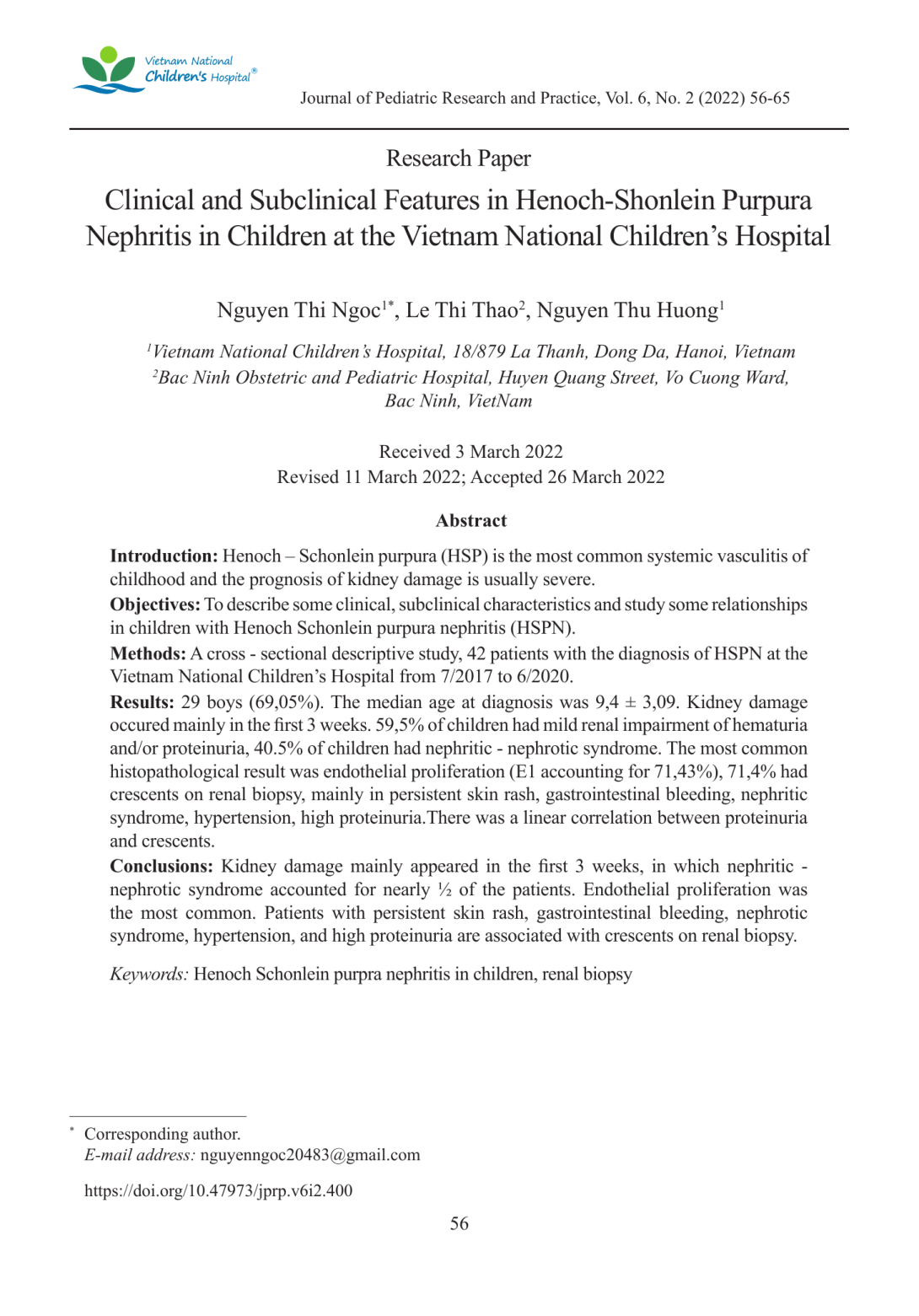
Schonlein Henoch là bệnh viêm mao mạch phổ biến nhất ở trẻ em và biến chứng tổn thương thận thường tiên lượng nặng. Mục tiêu: mô tả đặc điểm lâm sàng, cận lâm sàng và tìm hiểu một số mối liên quan ở trẻ mắc bệnh thận Schonlein Henoch tại khoa Thận - Lọc máu, Bệnh viện Nhi Trung ương. Phương pháp: Nghiên cứu mô tả cắt ngang, 42 bệnh nhi đủ tiêu chuẩn nghiên cứu từ 7/2017- 6/2020. Kết quả: 29 trẻ nam (69,05%). Tuổi trung bình chẩn đoán bệnh là 9,4 ± 3,09. Tổn thương thận xuất hiện chủ yếu ở 3 tuần đầu. 59,5% trẻ tổn thương thận nhẹ tiểu máu và/hoặc protein niệu, 40,5% trẻ tổn thương hội chứng thận hư – viêm thận. Kết quả mô bệnh học (MBH) phổ biến nhất là tăng sinh nội mao mạch (E1 chiếm 71,43%).71,4% có liềm tế bào, gặp chủ yếu ở nhóm ban da kéo dài, xuất huyết tiêu hóa, hội chứng thận hư, tăng huyết áp và protein niệu cao. Có mối tương quan tuyến tính giữa protein niệu và liềm tế bào. Kết luận: Tổn thương thận chủ yếu xuất hiện 3 tuần đầu, trong đó hội chứng thận hư - viêm thận chiếm gần ½ số bệnh nhân. Tăng sinh nội mạch gặp nhiều nhất. Bệnh nhân ban da kéo dài, xuất huyết tiêu hóa, hội chứng thận hư, tăng huyết áp và protein niệu cao có mối liên quan với tổn thương liềm tế bào.
Henoch – Schonlein purpura (HSP) is the most common systemic vasculitis of childhood and the prognosis of kidney damage is usually severe. Objectives: To describe some clinical, subclinical characteristics and study some relationships in children with Henoch Schonlein purpura nephritis (HSPN). Methods: A cross - sectional descriptive study, 42 patients with the diagnosis of HSPN at the Vietnam National Children’s Hospital from 7/2017 to 6/2020. Results: 29 boys (69,05%). The median age at diagnosis was 9,4 ± 3,09. Kidney damage occured mainly in the first 3 weeks. 59,5% of children had mild renal impairment of hematuria and/or proteinuria, 40.5% of children had nephritic - nephrotic syndrome. The most common histopathological result was endothelial proliferation (E1 accounting for 71,43%), 71,4% had crescents on renal biopsy, mainly in persistent skin rash, gastrointestinal bleeding, nephritic syndrome, hypertension, high proteinuria.There was a linear correlation between proteinuria and crescents. Conclusions: Kidney damage mainly appeared in the first 3 weeks, in which nephritic - nephrotic syndrome accounted for nearly ½ of the patients. Endothelial proliferation was the most common. Patients with persistent skin rash, gastrointestinal bleeding, nephrotic syndrome, hypertension, and high proteinuria are associated with crescents on renal biopsy.
- Đăng nhập để gửi ý kiến
